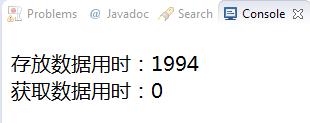Hash表实现的意义
作为数据类型的一种,Hash表做到了数组和链表两类基本数据类型的完美结合。Hash表继承两者的优点,让我们在做数据处理方面有了很多的方便,不但是时间上的还有空间上的。在数组中我们知道,存放的数据与及记录的关键字上没有太多的关系,很多都只是一个随机的关系。那么这样在我们进行相应的操作时,会大大的减少我们的工作效率,主要是因为找数据时会进行一系列的比较,这样消耗的比较的次数太多时花费的时间就会变多,自然而然效率就这样被削弱了。所以最最理想的情况就是我们能直接通过他们建立的关系,直接的找到结构中的位置来获取数据。
关系怎么建立呢
现在我们的主要任务就是找到方法来建立对应的关系。这里的方法其实有很多种。不同的数据采用的方法不同。主要有数据分析法、平均取中法、取余法、随机数等等方法。在这里不做具体的介绍。所以今天我在自定义自己的Hash表时,用的是JDK中提供的hashCode()方法。有兴趣的还可以相应的拓展。
Hash表到底是什么
真的是真的,听了我说上面的你也许还没有理解Hash表是个什么东东。一句话:就是以链表为元素的数组对象。在我们将数据放在这个所谓的数组对象时,有两种情况:1:原来数组在该下标已经有元素存在了,那么要放入的节点如果经过hashCode()及indexFor()方法计算过后他的下标也是一样的,那么我们采用挂链法将这个节点放到最后;2:如果没有,那么放到对应的index下标中,作为根节点。
最清楚的Hash表代码解释
说了这些肯定也不会马上理解,没事,我们来看代码。
为了大家能够看的清楚明了,这里我建立三个类:一个是链表类、一个是Hash表、一个是测试类
里面的方法都有详细的介绍,主要的是把思路理清。
链表Entry类:
package 哈希表1029;
/**
* 链表
* @author 祝侦科
*
*/
public class Entry<K,V> {
Entry<K,V> next;
K key;
V value;
int hash;
public Entry(K key,V value,int hash){
this.key = key;
this.value = value;
this.hash = hash;
}
}哈希表类:
package 哈希表1029;
/**
* 自定义的哈希表
* @author 祝侦科
*
*/
public class Hash<K,V> {
private int size;//链表数组的大小
private static int INIT_CAPACITY = 16;//默认的容量,即数组的大小
private static float LOAD_FACTOR = 0.75f;//默认的装载因子
private int max;//能存的最大的数
private Entry<K,V>[] entryArray;//链表数组
public Hash(int capacity,float factor){
this.INIT_CAPACITY = capacity;
max = (int)(capacity*factor);
entryArray = new Entry[capacity];
}
public Hash(){
this(INIT_CAPACITY, LOAD_FACTOR);
}
/**
* 根据hashcode及数组的容量来计算出该哈希码的下标
* @param hashcode hash值
* @param arraySize 数组长度
* @return 下标
*/
public int indexFor(int hashcode,int arraySize){
return hashcode & (arraySize-1);
}
/**
* 扩容以减少冲突阀值
* @param arraySize:扩容后新数组的容量
*/
public void reHash(int arraySize){
//创建扩容后的数组
Entry<K,V>[] newArray = new Entry[arraySize];
max = (int)(arraySize*LOAD_FACTOR);
for(int i=0;i<entryArray.length;i++){
//取得每一个链表对象
Entry<K,V> entry = entryArray[i];
while( null != entry){//遍历链表的每个节点,并且将节点加到新的数组中
this.setEntry(entry, newArray);
entry = entry.next;
}
}
entryArray = newArray;//将新的数组赋给原来的数组
}
/**
* 将节点放到链表数组中
* @param temp:要放入的节点
* @param entryArray:放到这个数组中
* @return:没有完全相同的则返回true,否则false
*/
public boolean setEntry(Entry<K,V> temp,Entry[] entryArray){
int index = this.indexFor(temp.hashCode(), entryArray.length);//获取要放入的节点的下标
Entry<K,V> entry = entryArray[index];//得到对应的链表对象
if(entry != null){//在while循环中遍历这个链表
while(null != entry){//遍历整个链表是为了发现是否有相同的节点
if((temp.key == entry.key || temp.key.equals(entry.key))
&&(temp.value == entry.value || temp.value.equals(entry.value))
&& temp.hash == entry.hash){
return false;//这里要注意比较的方法。。要两种情况都比较
}
//只有key相同时,value不同时
else if(temp.key == entry.key && temp.value != entry.value){
entry.value = temp.value;
return true;
}
//当key不同时,则比较下一个元素
else if(temp.key != entry.key){
if(null == entry.next){
break;
}
entry = entry.next;
}
}
//如果没有发现相同的话,则挂在最后面
this.addLastEntry(entry, temp);
return true;
}
//当entry为null时,将元素放在最开始
this.addFirstEntry(temp, entryArray, index);
return true;
}
/**
* 将数据存到Hash表中
* @param k
* @param v
* @return
*/
public boolean put(K k,V v){
int hash = k.hashCode();//首先计算出hash值
Entry<K,V> entry = new Entry(k,v,hash);
//将entry加到数组中
if(setEntry(entry, entryArray)){
size++;
return true;
}
return false;
}
public V get (K k){
//先得到下标
int hash = k.hashCode();
int index = this.indexFor(hash, entryArray.length);
//得到链表
Entry<K,V> entry = entryArray[index];
if(entry == null){
return null;
}
//遍历整个链表。。比较k值是否相等。。相等则返回对应的value
while(null == entry){
if(entry.key == k || entry.key.equals(k)){
return entry.value;
}
entry = entry.next;
}
//不等的话则返回null
return null;
}
/**
* 要放的节点要放在某个数组元素(未有元素)中时,将节点设为根节点
* @param temp:要放入的链表
* @param entryArray:链表放入的数组
* @param index:链表在数组中的下标
*/
public void addFirstEntry(Entry<K,V> temp,Entry[] entryArray,int index){
if(size > max){//如果容量超标,则扩容
this.reHash(entryArray.length*2);
}
entryArray[index] = temp;//将链表放在指定的下标中
temp.next = null;//temp是根节点,后面什么都没有了
}
/**
* 挂链法:将加点挂到相应节点的后面
***** !!!!!第二个节点参数在后面的!!!!!****(这个顺序要注意!!)
* @param entry:要挂在这个节点的后面
* @param temp:要挂的节点
*/
public void addLastEntry(Entry<K,V> entry,Entry<K,V> temp){
if(size >max){
reHash(entryArray.length);
}
entry.next = temp;//挂在后面
}
}
最后是测试类:
package 哈希表1029;
public class HashTest {
/**
* @param args
*/
public static void main(String[] args) {
new HashTest().test(args);
}
public void test(String[] args){
Hash<String ,String> hash = new Hash<String,String>();
long beginPut = System.currentTimeMillis();
for(int i=0;i<1000000;i++){
hash.put("", ""+i);
}
long endPut = System.currentTimeMillis();
System.out.println("存放数据用时:"+(endPut-beginPut));
long beginGet = System.currentTimeMillis();
hash.get(""+10000);
long endGet = System.currentTimeMillis();
System.out.println("获取数据用时:"+(endGet-beginGet));
}
}
随后最后运行的结果是:

希望我的讲解能给大家的Hash表的学习带帮助,也希望大家能够多多给我提建议,大家共同进步!
附件:
Hash表源代码包























 1858
1858

 被折叠的 条评论
为什么被折叠?
被折叠的 条评论
为什么被折叠?








